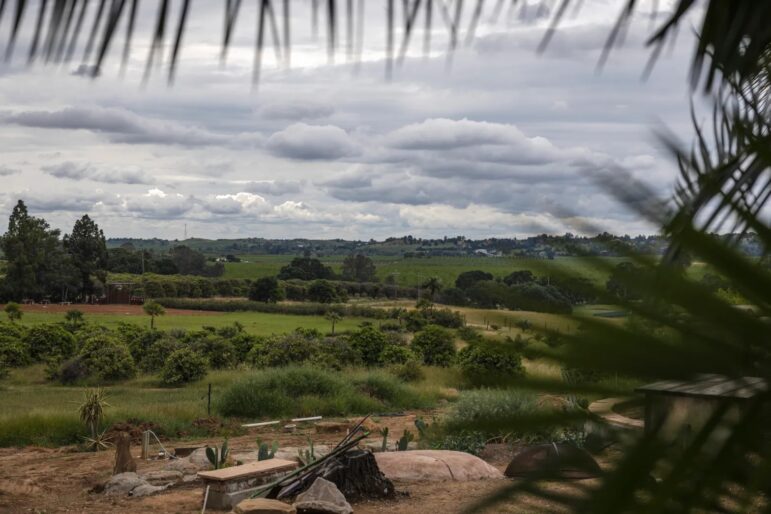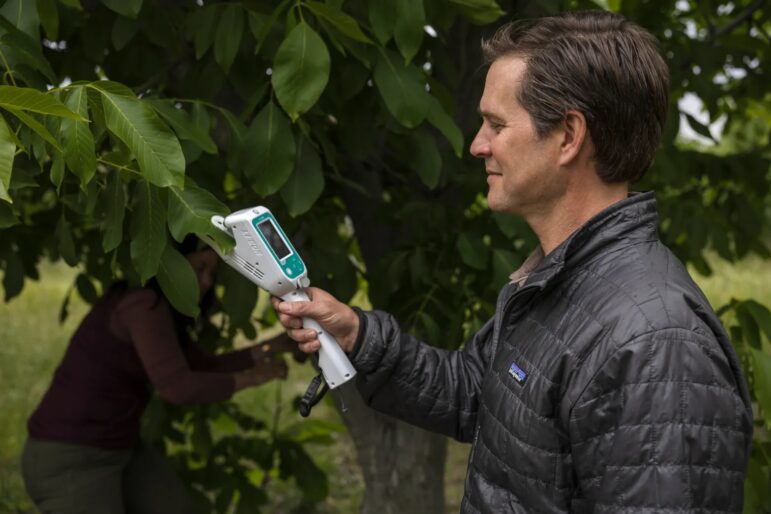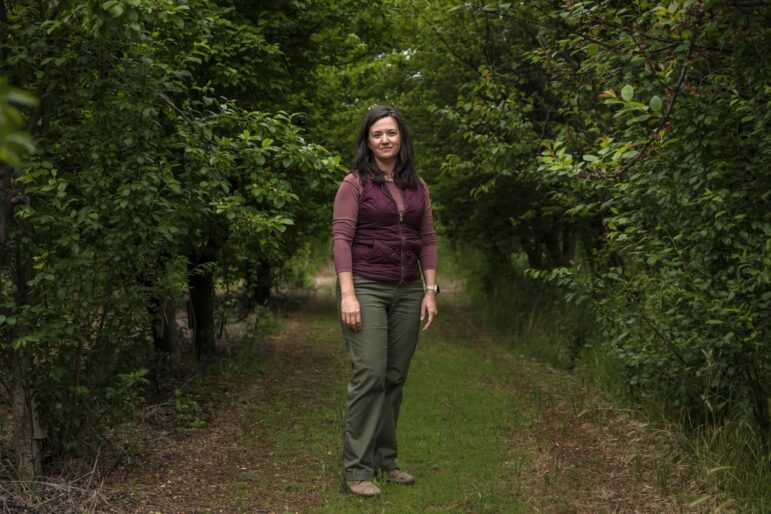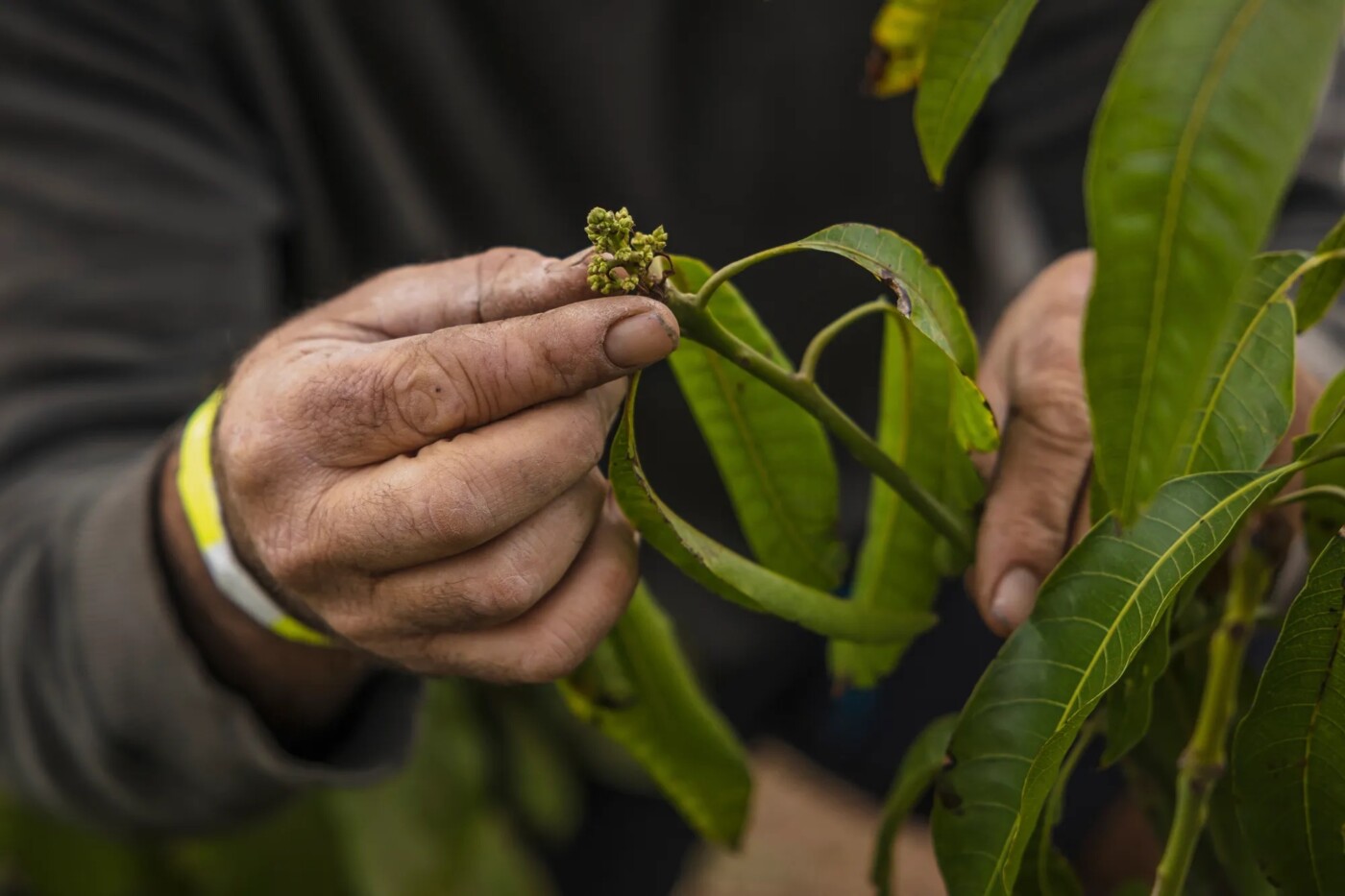In a world of worsening heatwaves, flooding, drought, glacial melting, megafires and other calamities of a changing climate, Gary Gragg is an optimist.
As California warms, Gragg — a nurseryman, micro-scale farmer and tropical fruit enthusiast — looks forward to the day that he can grow and sell mangoes in Northern California.
“I’ve been banking on this since I was 10 years old and first heard about global warming,” said Gragg, 54, who has planted several mango trees, among other subtropical trees, in his orchard about 25 miles west of Sacramento.
Gragg’s little orchard might be the continent’s northernmost grove of mangoes, which normally are grown in places like Florida, Hawaii and Puerto Rico.
Northern California’s climate, he said, is becoming increasingly suitable for heat-loving, frost-sensitive mango trees, as well as avocados, cherimoyas and tropical palms, a specialty of his plant nursery Golden Gate Palms.
“Climate change isn’t all bad,” Gragg said. “People almost never talk about the positives of global warming, but there will be winners and losers everywhere.”
Mangoes may never become a mainstream crop in the northern half of California, but change is undoubtedly coming. Hustling to adapt, farmers around the state are experimenting with new, more sustainable crops and varieties bred to better tolerate drought, heat, humidity and other elements of the increasingly unruly climate.
In the Central Valley, farmers are investing in avocados, which are traditionally planted farther south, and agave, a drought-resistant succulent grown in Mexico to make tequila.
In Santa Cruz, one grower is trying a tropical exotic, lucuma, that is native to South American regions with mild winters. Others are growing tropical dragonfruit from the Central Coast down to San Diego.
Some Sonoma and Napa Valley wineries have planted new vineyards in cooler coastal hills and valleys to escape the extreme heat of inland areas. And several Bay Area farmers have planted yangmei, a delicacy in China that can resist blights that ravage peaches and other popular California crops during rainy springs.
Near the town of Linden, farmer Mike Machado, who served in the state Assembly and Senate from 1994 to 2008, is one of many growers in the arid San Joaquin Valley who have replaced some stone fruit and nut trees with olives, historically a minor California crop mostly produced in Mediterranean nations.
“We’re adjusting for survival,” Machado said.
Climate change essentially means that Southern California’s conditions are creeping north up the coast and into the valley, while Oregon and Washington are becoming more like Northern California. Precipitation, winds, fog, and seasonal and daily temperature patterns — all of which determine which crops can be grown where — have all been altered.
“With climate change, we’re getting more erratic entries into fall and more erratic entries into spring,” said Louise Ferguson, a UC Davis plant physiologist.
Researchers predicted that “climatic conditions by the middle to end of the 21st century will no longer support some of the main tree crops currently grown in California.…For some crops, production might no longer be possible.”
“Fruit growers all around the world in the warm regions are worried about” warming trends, particularly in winter, said Eike Luedeling, a coauthor of the study and a professor of horticultural sciences at Germany’s University of Bonn.
UC Davis researchers are at the cutting edge of the push to adapt, working to make California’s lucrative walnut, pistachio and stone fruit orchards more resilient by selectively breeding for heat, disease and drought tolerance.
About three-quarters of the nation’s fruits and nuts are grown in California, but fruit and nut trees are among the most vulnerable crops to climate change.
Luedeling’s research, for example, suggests that high winter temperatures could severely reduce walnut yields about once a decade.
Katherine Jarvis-Shean, an orchard advisor with the UC Agriculture and Natural Resources program, said that effect will be magnified farther south: “That’s probably one in five years in the southern San Joaquin Valley,” she said.
Searching for genetic resilience
Pistachios have grown to one of the state’s mightiest crops, with acreage of mature trees now covering more than 400,000 acres. The 2021 harvest totaled about 577,000 tons and was valued at nearly $3 billion.
Now crop scientists are working to save these valuable orchards from the effects of warming.
Warmer winters can cause male varieties to bloom and release pollen too late, after the female flowers have opened. This means less pollination and less fruit, and in 2015 many orchards suffered total crop failure.
Patrick Brown, a UC Davis nut crop breeder, said farmers have solved this problem, at least for now, by grafting additional male varieties with different blooming schedules into the groves. “It’s a fairly easy hedge against that problem (of warmer winters),” he said. “No matter when the females bloom, there should be some pollen for them.”
Breeding programs to reduce nuts’ chill requirements are underway, but Brown said these trees have trade-offs: They tend to wake up earlier from winter dormancy, which can put premature foliage at risk of frost damage and expose young leaves to rainfall that causes blight.
Brown is now leading a hunt for genetic resistance to walnut blight in the shady groves of the Wolfskill Experimental Orchard, a repository of nearly 9,000 grapevine and tree fruit varieties from around the world. This genetic bank, owned by UC Davis and jointly run with the U.S. Department of Agriculture, includes walnut trees of several species and hundreds of varieties.

Brown’s experiment involves showering the walnuts with sprinklers in spring and summer and observing which develop the symptoms of blight — oil-black stains on the leaves and fruit.
His research is focused on walnut trees grown from seeds collected in the Republic of Georgia, where humidity creates conditions amenable to the disease. This likely has created localized genetic resistance — what Brown hopes to find.
“It gets pretty hot and humid (in Georgia) during the growing season, and if there’s resistance to blight anywhere, that would probably be a good place to look,” he said.
Still other problems are emerging as California’s weather patterns grow more erratic.
Early fall rains have been a problem for walnuts, spoiling ripening fruits. And heat waves — especially when they follow a rain event — can cause fruit to drop or spoil. Almost 40% of last fall’s walnut crop was lost when Central Valley temperatures approached 115 degrees, according to Robert Verloop, executive director of the California Walnut Board and the California Walnut Commission.
Walnut growers “are worried about heatwaves, and they should be,” Jarvis-Shean said.

Another UC Davis study at the Wolfskill orchard aims to identify genes for heat tolerance in European walnut trees. Claire Heinitz, a U.S. Department of Agriculture research leader, said trees are sampled with an instrument that measures photosynthesis. The idea is to find unique individuals that maintain basic functions under brutal heat conditions.
This year, she said, the project, led by researchers Andrew McElrone and Mina Momayyezi, might be expanded to include grapes, which are highly prone to heat damage, as well as pistachios and almonds.
Heinitz said much of the research aims to create hardier root systems, which can protect the trees against soil pathogens, salts and other stressors. However, breeding drought resilience into California’s major crops may be a more elusive goal.
“Drought tolerance is a really tough nut to crack, because it doesn’t just involve roots — it involves every system of the plant,” Heinitz said.
The winter of 2023 was an unusually cold one, but it hardly suggests a trend toward nut-friendly weather.
UCLA climate scientist Daniel Swain said last month that the low temperatures of the past several months were “a fluke” amid a long-term trajectory of increasingly warm winters. In fact, he said, “this may well be the coldest winter that some places will see now for the rest of our lives.”
If true, that could mean smooth sailing for Chiles Wilson Jr. and his family. A fifth-generation Sacramento-San Joaquin Delta farmer, Wilson has planted thousands of avocado trees of a dozen varieties near Walnut Grove and Cortland. Now the fruit, harvested almost year-round, is a key component of the family’s fruit-packing company, Rivermaid.
Most California avocados are grown between San Diego and Santa Barbara, covering nearly 50,000 acres and producing more than $300 million in direct farm sales.
Wilson recalls that when he pitched the avocado idea to his family nearly a decade ago, they discouraged him.
“They said, ‘Nah, they won’t produce here,’” he said. “And I said, ‘But that one does.’” He pointed to a large, fruit-laden avocado tree within sight of the farm’s main office. They gave it a shot, planting more than 600 avocado trees per acre.
Wilson knows, even in an era of warming, that his avocado orchards are a gamble. “We’re one killer freeze away from being wiped out,” Wilson said.
However, this winter, the temperature dipped below freezing 16 times in the Wilsons’ avocado groves, yet the trees survived and are producing fruit.
Still other fruits, barely known to most Americans, could rise to greatness in a warmer California. Charlie Lucero, a home orchardist in Menlo Park, is helping introduce Californians to yangmei. Lychee-like red orbs with pits inside like a cherry and a taste like pomegranate and pine resin, yangmei are typically grown in China.
Now Lucero is serving as a consultant and marketer for several Northern California growers who are preparing to harvest their second crop.

Lucero said the fruit — a relative of the bayberry — has “zero chill requirement” and is also resistant to fungi and bacteria that can plague stone fruit growers.
“If we get a late rain, it doesn’t hurt us,” Lucero said of his small yangmei collaborative, called Calmei. “These trees are well suited for California, where the weather is becoming less predictable.”
Lucero said they’ve been retailing for about $60 a pound. Last year’s crop totaled about 2.5 tons; this year, he expects about twice that.
An orchard project near Santa Cruz offers another glimpse into California’s possible future of farming.
Nate Blackmore of Wildlands Farm and Nursery is planting several acres with subtropical fruits, mostly from Central and South America — white sapote, ice cream bean, cherimoya, uvaia, dragonfruit and guabiroba.
The main attraction of his up-and-coming orchard will be lucuma trees. Native to western South America, lucuma resembles a round avocado with a pointed bottom, with mealy, sweet flesh like a yam.
All these species are tolerant of frost — but just barely.
“It’s so scary having all these subtropical fruit trees, and wondering how many would survive a bad freeze,” Blackmore said.
Yet another tropical crop could gain an advantage from California’s warming climate: coffee.
It’s being grown at orchards in Santa Barbara, Ventura and San Diego counties, and it’s not cheap: One company is selling organic coffee beans for $286 per pound. But the trees are hardly sustainable in those regions, which are reliant on water imported from Northern California and the Colorado River: Watering them takes at least several feet of water per year.
Another tropical fruit more suitable for drought-prone land is the pitaya, or dragonfruit. Grown from tropical cactus plants, it can be farmed in California with as little as 1.5 feet of applied water — a third of what citrus and avocados need, according to Ramiro Lobo, a San Diego County farm advisor with the UC Cooperative Extension program. His program has distributed about 50,000 dragonfruit cactus cuttings to small farmers from San Luis Obispo down to San Diego and at least 1,000 acres are in production.
Dry farming to cope with water scarcity
Among all the pressures for California farmers, none is so persistent and serious as water supply. The agriculture industry uses about 80% of the water Californians consume. During droughts, farmers — especially those growing some 4 million acres of grapevines and fruit trees — pump water from the ground.
This has caused thousands of drinking water wells to run dry and land to sink as aquifers shrivel. The state passed a new groundwater law in 2014 that is beginning to take effect, and could force as much as 900,000 acres of irrigated cropland, mostly in the arid San Joaquin Valley, out of production.
But this is inconsequential to farmers like Tristan Benson. Based in western Sonoma County, he practices dry farming.
Benson and his partners usually harvest 20 to 30 tons of heirloom wheat and barley from loamy hillsides, selling the grain for use in bread, beer and distilling. To grow these staples, they just need a little rain, forgoing the irrigation that other growers, like those in the Central and Imperial valleys, rely upon.
Even through recent droughts, Benson said, he has always pulled in a crop. “The closer to the coast we are, the better we do,” he said. Fields are planted in October or November, and about a week after the first heavy rain, the seeds germinate, and usually the ground stays moist until the summer harvest time.
Benson’s methods could be a model for sustainability for other California growers, who have “planted millions of acres of trees that always need water, and our reservoirs have at most a three-year supply,” he said.

Benson thinks a smart farming model is to grow winter crops without irrigation, and when reservoirs are full — as they are now — plant irrigated fields with annual summer fruits and vegetables. Apples, tomatoes, pears, grapes and potatoes can all be dry-farmed in cooler regions; farther inland and to the south, dry farming is more challenging, at least for most crops.
Geoff Vanden Heuvel, director of regulatory and economic affairs at the Milk Producers Council, said winter farming of grain and feed crops, with just a few inches of irrigation water, could help feed livestock with less groundwater use.
More than a quarter of the state’s feed crops are grown in areas entirely reliant on groundwater, and this dependency will likely translate into fewer California cows in the future, he said. By the 2040s, when the groundwater law takes full effect, dairy herds are expected to drop by about 10%. “That’s about 130,000 fewer cows,” Vanden Heuvel said.
Ferguson of UC Davis said Central Valley farmers have grown accustomed to harvesting maximum yields because “we had more reliable water. Maybe now, when we don’t have the water or it’s more expensive, they’ll have to settle for a lower yield.”
Daniel Sumner, a UC Davis professor of agricultural and resource economics, said California’s agricultural identity already has changed drastically over time. In its earliest days of statehood, California was a major producer of rain-watered wheat, grown on several million acres. When irrigation became ubiquitous, so did specialty crops that thrive in a hot, dry climate but need water in the summer.
Almonds now cover more than 1.6 million acres of the Central Valley, and pistachios have seen explosive growth, “from almost nothing to a $2 billion crop in a few decades.”
He said predicting what crops will be trending in California in several decades is impossible, “but it’s hard to picture that we wouldn’t stay a specialty crop producer,” he said.
Economic turbulence, too
It’s not just the changing climate that’s guiding the future of one of California’s top industries. In the decades to come, growers will experience economic shifts, competition from imports and rising labor costs.
The increasing minimum wage, for example, has made even some high-value crops, like table olives, unprofitable to grow in California unless machines prune the trees and pick the fruit. Hand-based labor can suck up 45 to 60% of gross revenue, largely because olives must be carefully handled.
Spain, the world’s superproducer of olives, generates a cheaper product and has forced California growers to adapt, said Dennis Burreson, a vice-president at the Musco Family Olive Co., based in Tracy.
Burreson said machine harvesting is now becoming standard for many tree crops, adding, “eventually, I think hand-harvesting of many orchard crops is going to be in the rear-view mirror.”
Meanwhile, the state’s mighty walnut industry has been knocked on its side as oversupply and competition from China have sent prices crashing. In 2013, a ton of walnuts sold off the farm for $3,700. Now it’s about $700 per ton. On top of that, growers “are still sitting on 130,000 tons of the 2021 crop,” Verloop said, with some of that excess distributed to food banks.
So many walnut growers are now reportedly scheduled to have their trees uprooted and chipped that removal services can’t keep up.
Sumner said the economic upheaval of the walnut industry “doesn’t look like it’s turning around.”
Brown suspects that labor costs and land values will be just as strong drivers of agriculture’s evolution as the changing climate. Other regions of the world are producing crops for less, he said, which means California’s specialties will be niche and higher-quality produce.
“Whatever is going to be grown in California in 50 years,” he said, “is what can’t be grown elsewhere or what can be grown better here.”
